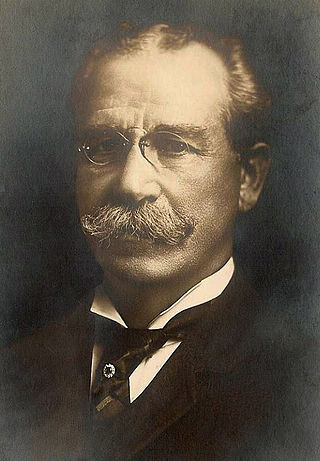
Artificial lighting technology began to be developed tens of thousands of years ago and continues to be refined in the present day.

Adolphus Busch was the German-born co-founder of Anheuser-Busch with his father-in-law, Eberhard Anheuser. He introduced numerous innovations, building the success of the company in the late 19th and early 20th centuries. He became a philanthropist, using some of his wealth for education and humanitarian needs. His great-great-grandson, August Busch IV, is a former CEO of Anheuser-Busch.

Gas lighting is the production of artificial light from combustion of a fuel gas such as methane, propane, butane, acetylene, ethylene, hydrogen, carbon monoxide, coal gas or natural gas. The light is produced either directly by the flame, generally by using special mixes of illuminating gas to increase brightness, or indirectly with other components such as the gas mantle or the limelight, with the gas primarily functioning to heat the mantle or the lime to incandescence.

Emera Incorporated is a publicly traded Canadian multinational energy holding company based in Halifax, Nova Scotia. Created in 1998 during the privatization of Nova Scotia Power, a provincial Crown corporation, Emera now invests in regulated electricity generation as well as transmission and distribution across North America and the Caribbean.

The North American Company was a holding company incorporated in New Jersey on June 14, 1890, and controlled by Henry Villard, to succeed to the assets and property of the Oregon and Transcontinental Company. It owned public utilities and public transport companies and was broken up in 1946, largely to comply with the Public Utility Holding Company Act of 1935.

Ameren Corporation is an American power company created December 31, 1997, by the merger of Union Electric Company of St. Louis, Missouri and the neighboring Central Illinois Public Service Company of Springfield, Illinois. It is now a holding company for several power companies and energy companies. The company is based in St. Louis, with 2.4 million electric, and 900,000 natural gas customers across 64,000 square miles in central and eastern Missouri and the southern four-fifths of Illinois by area.
The Union Electric Company of Missouri was an electric power utility that was organized in 1902 and grew to be one of the large U.S. companies listed among the S&P 500. In 1997, its holding company merged with a smaller neighboring utility, Central Illinois Public Service Company through its holding company, CIPSCO Inc., to form Ameren Corporation based in St. Louis, Missouri.

Alabama Gas Corporation, known as Alagasco, was the largest natural gas utility in the north and central part of Alabama. It was headquartered in Birmingham and at its peak provided natural gas energy to 460,000 homes and businesses.
Tucson Electric Power (TEP) is an electric utility company serving southern Arizona in the United States. It is a subsidiary of Fortis, which announced its acquisition of parent company UNS Energy in 2013.

John Irvin Beggs was an American businessman. He was associated closely with the electric utility boom under Thomas Edison. He was also associated with Milwaukee, St. Louis, Missouri, and other regional rail and interurban trolley systems. Beggs is also known for developing modern depreciation techniques for business accounting and for being one of the early directors of what became General Electric.
FortisBC is a British Columbia based regulated utility that provides natural gas and electricity. FortisBC has approximately 2,600 employees serving more than 1.2 million customers in 135 B.C. communities and 58 First Nations communities across 150 Traditional Territories.
Evergy, Inc. is an American investor-owned utility (IOU) with publicly traded stock with headquarters in Topeka, Kansas, and in Kansas City, Missouri. The company was formed from a merger of Westar Energy of Topeka and Great Plains Energy of Kansas City, parent company of Kansas City Power & Light. Evergy is the largest electric company in Kansas, serving more than 1.7 million residential, commercial and industrial customers in Kansas and Missouri. Its more than 40 power plants have generating capacity of 16,000 megawatt electricity in Kansas and Missouri. Service territory covers 28,130 square miles (72,900 km2) in east Kansas and west Missouri. It owns more than 10,100 miles (16,300 km) of transmission lines and about 52,000 miles (84,000 km) of distribution lines.

Spire Inc. is a regional public utility holding company based in St. Louis, Missouri, providing natural gas service through its regulated core utility operations while engaging in non-regulated activities that provide business opportunities. Its primary subsidiary Laclede Gas Company is the largest natural gas distribution utility in Missouri, serving approximately 631,000 residential, commercial and industrial customers in the City of St. Louis and ten counties in eastern Missouri. Its corporate headquarters is located in the 700 Market building in downtown St. Louis.

Streetcars in St. Louis, Missouri, operated as part of the transportation network of St. Louis from the middle of the 19th century through the early 1960s.
Missouri Gas Energy (MGE) was a natural gas distribution company headquartered in Kansas City, Missouri in the United States, with offices in St. Joseph, Lee's Summit, Warrensburg, Joplin, Republic, Neosho and Monett. MGE served over in 155 western Missouri communities and was a division of the Southern Union Company until it was ultimately sold to the Spire Inc. Its business is regulated by the Missouri Public Service Commission.
Algonquin Power & Utilities Corp. is a Canadian renewable energy and regulated utility conglomerate with assets across North America. Algonquin actively invests in hydroelectric, wind and solar power facilities, and utility businesses, through its three operating subsidiaries: Bermuda Electric Light Company, Liberty Power and Liberty Utilities.
Mobile Gas, headquartered in Mobile, Alabama, was the largest natural gas utility in coastal Alabama that provided energy to 89,000 homes and businesses. Its operations dated back to 1836 when it began providing gas lighting for the city of Mobile. It had distribution territory in the cities of Mobile, Prichard, Saraland, Satsuma, Semmes, Bayou La Batre, Creola, Mt. Vernon, Spanish Fort, and Loxley. Within those cities, Mobile Gas operated 2,250 miles of pipeline and about 46 miles of transmission lines.
The Electro-Dynamic Light Company of New York was a lighting and electrical distribution company organized in 1878. The company held the patents for the first practical incandescent electric lamp and electrical distribution system of incandescent electric lighting. They also held a patent for an electric meter to measure the amount of electricity used. The inventions were those of Albon Man and William E. Sawyer. They gave the patent rights to the company, which they had formed with a group of businessmen. It was the first company in the world formally established to provided electric lighting and was the first company organized specifically to manufacture and sell incandescent electric light bulbs.










